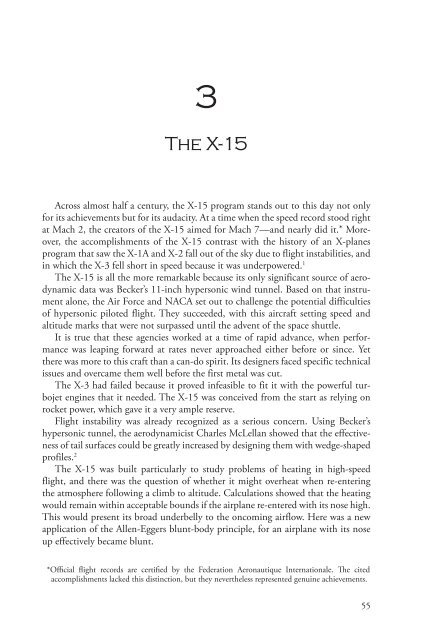Facing the Heat Barrier - NASA's History Office
Facing the Heat Barrier - NASA's History Office
Facing the Heat Barrier - NASA's History Office
You also want an ePaper? Increase the reach of your titles
YUMPU automatically turns print PDFs into web optimized ePapers that Google loves.
3<br />
The X-15<br />
Across almost half a century, <strong>the</strong> X-15 program stands out to this day not only<br />
for its achievements but for its audacity. At a time when <strong>the</strong> speed record stood right<br />
at Mach 2, <strong>the</strong> creators of <strong>the</strong> X-15 aimed for Mach 7—and nearly did it.* Moreover,<br />
<strong>the</strong> accomplishments of <strong>the</strong> X-15 contrast with <strong>the</strong> history of an X-planes<br />
program that saw <strong>the</strong> X-1A and X-2 fall out of <strong>the</strong> sky due to flight instabilities, and<br />
in which <strong>the</strong> X-3 fell short in speed because it was underpowered. 1<br />
The X-15 is all <strong>the</strong> more remarkable because its only significant source of aerodynamic<br />
data was Becker’s 11-inch hypersonic wind tunnel. Based on that instrument<br />
alone, <strong>the</strong> Air Force and NACA set out to challenge <strong>the</strong> potential difficulties<br />
of hypersonic piloted flight. They succeeded, with this aircraft setting speed and<br />
altitude marks that were not surpassed until <strong>the</strong> advent of <strong>the</strong> space shuttle.<br />
It is true that <strong>the</strong>se agencies worked at a time of rapid advance, when performance<br />
was leaping forward at rates never approached ei<strong>the</strong>r before or since. Yet<br />
<strong>the</strong>re was more to this craft than a can-do spirit. Its designers faced specific technical<br />
issues and overcame <strong>the</strong>m well before <strong>the</strong> first metal was cut.<br />
The X-3 had failed because it proved infeasible to fit it with <strong>the</strong> powerful turbojet<br />
engines that it needed. The X-15 was conceived from <strong>the</strong> start as relying on<br />
rocket power, which gave it a very ample reserve.<br />
Flight instability was already recognized as a serious concern. Using Becker’s<br />
hypersonic tunnel, <strong>the</strong> aerodynamicist Charles McLellan showed that <strong>the</strong> effectiveness<br />
of tail surfaces could be greatly increased by designing <strong>the</strong>m with wedge-shaped<br />
profiles. 2<br />
The X-15 was built particularly to study problems of heating in high-speed<br />
flight, and <strong>the</strong>re was <strong>the</strong> question of whe<strong>the</strong>r it might overheat when re-entering<br />
<strong>the</strong> atmosphere following a climb to altitude. Calculations showed that <strong>the</strong> heating<br />
would remain within acceptable bounds if <strong>the</strong> airplane re-entered with its nose high.<br />
This would present its broad underbelly to <strong>the</strong> oncoming airflow. Here was a new<br />
application of <strong>the</strong> Allen-Eggers blunt-body principle, for an airplane with its nose<br />
up effectively became blunt.<br />
*Official flight records are certified by <strong>the</strong> Federation Aeronautique Internationale. The cited<br />
accomplishments lacked this distinction, but <strong>the</strong>y never<strong>the</strong>less represented genuine achievements.<br />
55
















